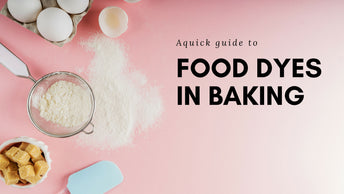Food Coloring in Baking: History, Health Concerns, and Usage

They say you eat with your eyes before you taste with your taste buds and our eyes love the color. Your childhood likely included a few instances of brown mystery meat beneath brown gravy that made you shrink back in terror at the thought of having to eat it. That is why bakeries around the world use vibrant colors to draw your eye to long, glass cases where row after row of pies, cakes, and pastries seem to call out to you to join their celebration. Color is fun, it's exciting, it's playful, and it draws us in. But how to bakeries, in particular, get such vibrant colors in their cakes, pies, and frostings? Simple, they use food coloring.
A (VERY) BRIEF HISTORY OF FOOD COLORING

There is evidence that plants were used as natural dyes for wine, food, clothing, and even skin back in ancient Egypt. Early American settlers used beets to color frostings, coffee grounds to tint fabrics and even cherries to give home-canned applesauce an appealing, rosy color. Artificial coloring as we know it first appeared in 1856 when William Henry Perkin invented the first synthetic dye known as "mauvine". However, this and many other artificial coloring agents were not necessarily safe to consume. Many were made from coal byproducts, lead, and copper arsenite which in many cases caused illness or even death. In 1906, the FDA began addressing the safety of food additives, including colorings and imposed regulations on the types and amounts that could be found in food and cosmetics. In 1938 they began using the abbreviations FD&C, D&C, and Ext. D&C for food coloring that was certified as safe. (Ever heard of FD&C Red #40? More on that in a minute.)
HEALTH CONCERNS
Today, prior to being certified for human consumption, the FDA conducts an investigation into the origins and safety of any dyes or pigments that are going to be added to food or cosmetics. Food coloring or color additives tend to fall into two categories - those that are exempt from certification such as plant or mineral sourced dyes, and those that are subject to certification such as those sourced from petroleum products. Yet many people are wary of consuming food dyes, even once they have been approved by the FDA. While some studies have linked food coloring to everything from ADHD to autism, these studies tend to fall apart under statistical scrutiny. In the end, natural and artificial coloring that has gone through the FDA certification process is safe to consume in recommended quantities.
HOW TO CHOOSE THE RIGHT FOOD COLORING
Choosing the right food coloring for your culinary pursuit largely depends on what you are cooking or baking. For instance, to keep a red velvet cake red instead of pink you need a food coloring that has a high pigment level. For a truly royal purple frosting, you need a food coloring that mixes easily and maintains a consistent tone without altering the texture of the frosting. However, you do not want to sacrifice color for flavor or texture. As a basic rule of thumb, the following apply.
Common Food Coloring Allergy
If you are concerned about food allergies or if you follow a vegan diet, choose a food coloring that is all-natural and plant-based. Find a vegan, nut-free, gluten-free, and egg-free food coloring that won't alter the texture or taste of your food. Just be aware that many times plant-based dyes sometimes do not have the same color saturation that artificial food coloring does.
FOOD COLORING FOR CHOCOLATE & CANDY

Oil-based food colorings are ideal for anything with a high-fat content such as buttercream frosting, coatings or chocolate. Never ever use a water-based or alcohol-based food coloring to color your chocolate because it will "seize" your chocolate, a process that will turn your chocolate into a messy paste.
The "seizing" happens because when chocolate is made, all moisture has been taken out and results in a dry up mixture of cocoa butter and sugar. And we know that oil (cocoa butter) and water don't mix!
That's why you need to use oil-based food colorings for the chocolate to avoid seizing.
Concentrated Food Colorings
Gel food coloring or liquid-gel food coloring is perfect for baking and cake decorating. Highly concentrated and vibrant, gel food dye offers a consistent color tone without changing the flavor or texture of the cake, frosting, cookie, fondant, or other product.
It is strongly recommended to test the gel food colorings before use to achieve the perfect color because they're extremely concentrated.
Another tip is that the colors in buttercream icing usually darken after 1 - 2 hours. This is perfectly normal, as the colors are exposed to air. Experience bakers usually color their icing a few hours prior to application.
Is Food Coloring Kosher/Halal?
Not all food coloring company can offer Kosher/Halal products. YAS INTL Food coloring is Halal. In general, most companies will have their Kosher/Halal symbol on their products if they are certified for Kosher or Halal.
CLOSING THOUGHTS
Ultimately, using food coloring in cooking or baking is a personal choice. However, with so many options on the market YAS INTL keeps your health concerns in mind and manufactures products that yield beautiful results with minimal use, there is no reason not to give your eyes a feast before your taste buds.



